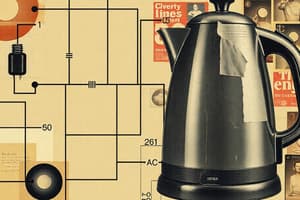Podcast
Questions and Answers
What is the equation obtained by applying KVL for loop ABEFA?
What is the equation obtained by applying KVL for loop ABEFA?
- -5I1 - 10 - 10(I1 - I2) + 30 = 0
- -5I1 + 20 + 10(I1 - I2) - 40 = 0
- -5I1 - 10 - 20(I1 - I2) + 20 = 0
- -5I1 - 20 - 10(I1 - I2) + 40 = 0 (correct)
What is the equation obtained by multiplying equation (1) by 2 and equation (2) by 3?
What is the equation obtained by multiplying equation (1) by 2 and equation (2) by 3?
- -25I1 + 15I2 = -25, 25I1 - 30I2 = -30
- -15I1 + 12I2 = -15, 18I1 - 22I2 = -18
- -30I1 + 20I2 = -40, 30I1 - 36I2 = -30 (correct)
- -20I1 + 10I2 = -20, 20I1 - 24I2 = -20
What is the value of I2 in amperes?
What is the value of I2 in amperes?
- I2 = 5.125 Amp
- I2 = 6.25 Amp
- I2 = 4.375 Amp (correct)
- I2 = 3.75 Amp
What is the SI unit of electric work?
What is the SI unit of electric work?
What is the method used to analyze the given circuit?
What is the method used to analyze the given circuit?
What is the rate at which electrical energy is transferred by an electric circuit?
What is the rate at which electrical energy is transferred by an electric circuit?
What is the use of Cramer's Rule in circuit analysis?
What is the use of Cramer's Rule in circuit analysis?
What is the SI unit of power?
What is the SI unit of power?
What is the purpose of applying KVL for loop BCDEB?
What is the purpose of applying KVL for loop BCDEB?
What is the formula to calculate the resistance of a coil?
What is the formula to calculate the resistance of a coil?
What is the formula to calculate the current in a circuit?
What is the formula to calculate the current in a circuit?
What is the formula to calculate the power absorbed by a coil?
What is the formula to calculate the power absorbed by a coil?
What is the total length of the coil?
What is the total length of the coil?
What is the resistance of the coil?
What is the resistance of the coil?
What is the value of I1 when using Cramer's Rule?
What is the value of I1 when using Cramer's Rule?
What is the value of total current through the 10 ohm resistor?
What is the value of total current through the 10 ohm resistor?
What is the value of VB in the given circuit?
What is the value of VB in the given circuit?
What is the value of ∆ in Cramer's Rule?
What is the value of ∆ in Cramer's Rule?
What is the value of I2 when using Cramer's Rule?
What is the value of I2 when using Cramer's Rule?
What is the application of Node Analysis in this circuit?
What is the application of Node Analysis in this circuit?
What is the value of I when using Mesh Analysis?
What is the value of I when using Mesh Analysis?
What is the value of ∆1 in Cramer's Rule?
What is the value of ∆1 in Cramer's Rule?
What is the application of Cramer's Rule in this circuit?
What is the application of Cramer's Rule in this circuit?
What is the value of I1 + I2?
What is the value of I1 + I2?
Flashcards are hidden until you start studying
Study Notes
KVL and Circuit Analysis
- Applying Kirchhoff's Voltage Law (KVL) to loop ABEFA yields an equation describing voltage drops around the loop.
- Simplify the equation: -15I1 + 10I2 = -20
- Apply KVL to loop BCDEB: -2I2 + 10 - 10(I2 - I1) = 0
- Simplify the equation: 10I1 - 12I2 = -10
- Solve for I2 by multiplying equation (1) by 2 and equation (2) by 3, and then adding them: I2 = 4.375 Amp
- Solve for I1 by substituting I2 in equation (1): I1 = 4.25 Amp
Electric Work and Power
- Electric work: the work done per unit of charge
- SI unit of electric work: Joule
- Electric power: the rate at which electrical energy is transferred
- SI unit of electric power: Watt (one Joule per second)
Coil Resistance and Power
- Calculate the total length of the coil: ltotal = 160000 cm = 1600 m
- Calculate the resistance of the coil: R = 40 Ω
- Calculate the current: I = 2.75 Amp
- Calculate the power absorbed by the coil: P = 302.5 Watt
Equivalent Resistance in Parallel Connection
- Derive an expression for equivalent resistance: R_equivalent = (R1*R2)/(R1+R2)
- Calculate the total current through the 10 ohm resistor: I = I1 - I2 = -0.125 Amp
Node Analysis
- Apply KVL at node B: I1 + I2 + I3 = 0
- Solve for VB: VB = -1.25 V
- Calculate the total current through the 10 ohm resistor: I = VB/10 = -0.125 Amp
Studying That Suits You
Use AI to generate personalized quizzes and flashcards to suit your learning preferences.




